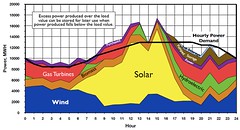 Solar power is the smart thing to do for jobs, energy independence, and profit. It’s also what we need to do to save water.
Solar power is the smart thing to do for jobs, energy independence, and profit. It’s also what we need to do to save water.
Julia Pyper and ClimateWire wrote for Scientific American 29 June 2012, Electricity Generation ‘Burning’ Rivers of Drought-Scorched Southeast: A new report reckons the water cost of electricity generation
Power plants are guzzling water across the United States and increasing the risk of blackouts in the Southeast, where the precious resource is drying up.
“Burning Our Rivers,” a new report by the River Network, found that it takes about 40,000 gallons of water to meet the average American household’s energy needs, which is five times more than the amount of water used directly in that home….
Table 3. Total Water Footprint of a Kilowatt-hour
(Gallons per kWh)
2009 U.S. Electric Grid
(National weighted average)Hydroelectric 29.920 Coal 7.143 Natural Gas 1.512 Nuclear 2.995 Geothermal 0.002 Solar 0.002 Wind 0.001 Total 41.575 In the Southeast, which has been battling a drought for more than a
year, the impact of power plants is especially worrisome and could lead to brownouts and blackouts throughout the summer and beyond.
“The conflicts between energy and water needs are ones we’ve seen before … and will only worsen as the frequency of drought increases and water temperatures rise driven in part by climate change,” said Ulla Reeves, regional program director at the Southern Alliance for Clean Energy.
The report’s number 1 recommendation:
1. As a nation, we should focus on renewable energy sources and low water technologies.
Why?
In many places, the freshwater used to generate electricity might be more valuable for other uses, such as drinking water for cities, irrigation water for farms or environmental flows for fisheries and habitat restoration.
In the long run, all Americans and economic sectors must recognize the
consequences and risks associated with wasting water. Already in many states, elevated water temperatures impact electrical production. A more volatile and less predictable hydrologic regime will make these “thirsty” technologies even less reliable. We can find more sustainable options by using the water-energy nexus as a crucial lens for analysis, management and planning.
More specifically, the report recommends:
1.1 Speed the retirement of out-of-date electric facilities and cooling technologies, and incentivize “water-friendly” renewable energy sources
Wind and PVsolar require virtually no water to generate electricity, and their lifecycle water footprints are far smaller than hydro, nuclear or fossil fuels. The technology exists for wind to provide 20% of our electricity by 2024.1 Since the majority of the water used by wind and PV solar is “upstream” (to acquire and process materials for fabrication), manufacturing can be focused in water rich regions without increasing water impacts in dry regions. A renewal of the federal Production Tax Credit would cut wind developmental costs by 25%.2 Establishing a price on greenhouse gas emissions with a carbon tax or a cap and trade system would also increase the cost competitiveness of the wind industry. Federal, states and local governments can give incentives for renewable energy development with feed-in tariff programs. States can also consider the water impacts of least-cost rate proceedings and stronger Renewable Energy Standards.
 Those estimates seem quite conservative; here are some others that project
powering everything with mostly solar and wind and less natural gas than we use now.
Those estimates seem quite conservative; here are some others that project
powering everything with mostly solar and wind and less natural gas than we use now.
Of course, in Georgia, there’s an even easier solution to getting solar deployed: fix the 1973 Georgia Territorial Electric Service Act so we can all get financing to put solar on our rooftops and parking lots, and so we can sell excess power to places that need it. It’s time for Georgia Power and the Southern Company to lead in deploying solar.
Solar power, for jobs, energy independence, profit: and for water!
-jsq
Short Link: